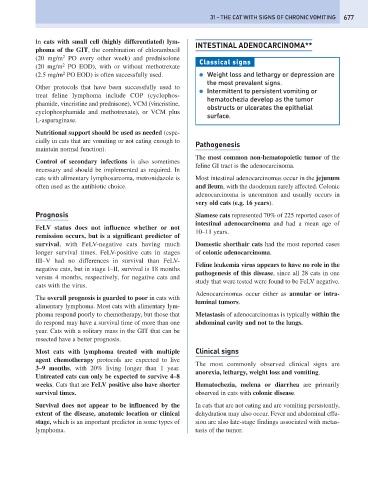Page 685 - Problem-Based Feline Medicine
P. 685
31 – THE CAT WITH SIGNS OF CHRONIC VOMITING 677
In cats with small cell (highly differentiated) lym- INTESTINAL ADENOCARCINOMA**
phoma of the GIT, the combination of chlorambucil
2
(20 mg/m PO every other week) and prednisolone Classical signs
2
(20 mg/m PO EOD), with or without methotrexate
2
(2.5 mg/m PO EOD) is often successfully used. ● Weight loss and lethargy or depression are
the most prevalent signs.
Other protocols that have been successfully used to
● Intermittent to persistent vomiting or
treat feline lymphoma include COP (cyclophos- hematochezia develop as the tumor
phamide, vincristine and prednisone), VCM (vincristine, obstructs or ulcerates the epithelial
cyclophosphamide and methotrexate), or VCM plus surface.
L-asparaginase.
Nutritional support should be used as needed (espe-
cially in cats that are vomiting or not eating enough to Pathogenesis
maintain normal function).
The most common non-hematopoietic tumor of the
Control of secondary infections is also sometimes
feline GI tract is the adenocarcinoma.
necessary and should be implemented as required. In
cats with alimentary lymphosarcoma, metronidazole is Most intestinal adenocarcinomas occur in the jejunum
often used as the antibiotic choice. and ileum, with the duodenum rarely affected. Colonic
adenocarcinoma is uncommon and usually occurs in
very old cats (e.g. 16 years).
Prognosis Siamese cats represented 70% of 225 reported cases of
intestinal adenocarcinoma and had a mean age of
FeLV status does not influence whether or not
10–11 years.
remission occurs, but is a significant predictor of
survival, with FeLV-negative cats having much Domestic shorthair cats had the most reported cases
longer survival times. FeLV-positive cats in stages of colonic adenocarcinoma.
III–V had no differences in survival than FeLV-
Feline leukemia virus appears to have no role in the
negative cats, but in stage I–II, survival is 18 months
pathogenesis of this disease, since all 28 cats in one
versus 4 months, respectively, for negative cats and
study that were tested were found to be FeLV negative.
cats with the virus.
Adenocarcinomas occur either as annular or intra-
The overall prognosis is guarded to poor in cats with
luminal tumors.
alimentary lymphoma. Most cats with alimentary lym-
phoma respond poorly to chemotherapy, but those that Metastasis of adenocarcinomas is typically within the
do respond may have a survival time of more than one abdominal cavity and not to the lungs.
year. Cats with a solitary mass in the GIT that can be
resected have a better prognosis.
Most cats with lymphoma treated with multiple Clinical signs
agent chemotherapy protocols are expected to live
The most commonly observed clinical signs are
3–9 months, with 20% living longer than 1 year.
anorexia, lethargy, weight loss and vomiting.
Untreated cats can only be expected to survive 4–8
weeks. Cats that are FeLV positive also have shorter Hematochezia, melena or diarrhea are primarily
survival times. observed in cats with colonic disease.
Survival does not appear to be influenced by the In cats that are not eating and are vomiting persistently,
extent of the disease, anatomic location or clinical dehydration may also occur. Fever and abdominal effu-
stage, which is an important predictor in some types of sion are also late-stage findings associated with metas-
lymphoma. tasis of the tumor.

